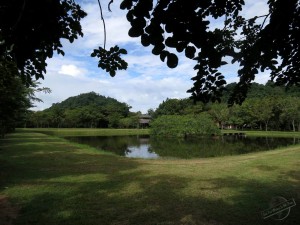Travel Day 1095 – Dhamma Hermitage, Wat Suan Mokkh, THAILAND
As it turned out, most of the teachings we had at Wat Suan Mokkh were about Anapanasiti or rather Mindfulness with Breathing…
Actually I was about to say that all the teachings were about Anapanasiti, the subject mainly studied and taught by Buddhadasa, but there was no way of knowing for sure since nobody had the slightest idea what the Yoda monk was teaching us. So the only actual Theravada teachings we received were by the cynical British monk who in turn had studied the innovative interpreter of the Buddha’s teachings, Buddhadasa Bhikkhu, for many years and now was translating some of his texts…
We learned that Anapanasiti or Mindfulness with Breathing was basically a 16 step process as outlined by the Buddha and it could be divided into four general segments. Twelve of these steps were concerned with conditioning of the mind while the fist four steps were of preparational nature and we mainly focused on them. In fact we were taught that fully understanding and experiencing the first four steps was actually a prerequisite for proper meditation…
The first four steps of Anapanasiti in this case were to experience and fully comprehend long in and long out breathing, to fully comprehend short in and short out breathing, to fully comprehend normal breathing as well as all other types of breathing and to fully contemplate on the breath. The breath itself was described as the “body conditioner” because wherever the breath would go, the mind would follow and in order to control the mind, one needed to develop control over one’s own breath first…
In order to develop more awareness and mindfulness of the breathing, all instructions we were given prior to our meditation sessions were to concentrate on the breath itself. We were to follow the breath from the nostrils down through the body to the bottom of the navel and then chase the breath upwards again as it was leaving the body up to the tip of the nose. Special attention was given on the actual chasing of the breath as well as the two points of stand-still between in and out breathing…
Ideally this stand-still was supposed to be found when the natural in-breath would turn into the natural out-breath and vice versa, without purposefully controlling the breath. But what seemed most important about this exercise was the development of mindfulness. In fact the whole breathing technique of Anapanasiti seemed to be developed to simply teach mindfulness and thus mindfulness became the main focus of our entire Vipassana retreat of the next couple of days…
In fact how important mindfulness actually was and how much we usually neglect it, we became painfully aware of when we were confronted with questions like “how does walking actually work?” or “how many spoons does it take to eat the rice soup in the morning?” These questions were to show us how little mindful and present we normally were. Instead of focusing on the rice soup and the present moment, our mind would normally wander around while thinking about all sorts of other unrelated things. This kind of mindfulness and awareness in combination with the breathing seemed to be not only the essence of Buddhadasa’s teachings but also of the teachings of the Buddha himself…
Find all Wat Suan Mokkh Photos here.



Self-love is a method of change of our inner self. Every individual has the desire that the person or the thing he loves must always be ideal. If an individual will love himself then, no doubt, he will make all the efforts to transform and establish himself and be a better person.
Thank you very much for your insights, that sounds indeed like a very good concept! The only addition I would make is, that despite the self-love it is still important not to place yourself above others…